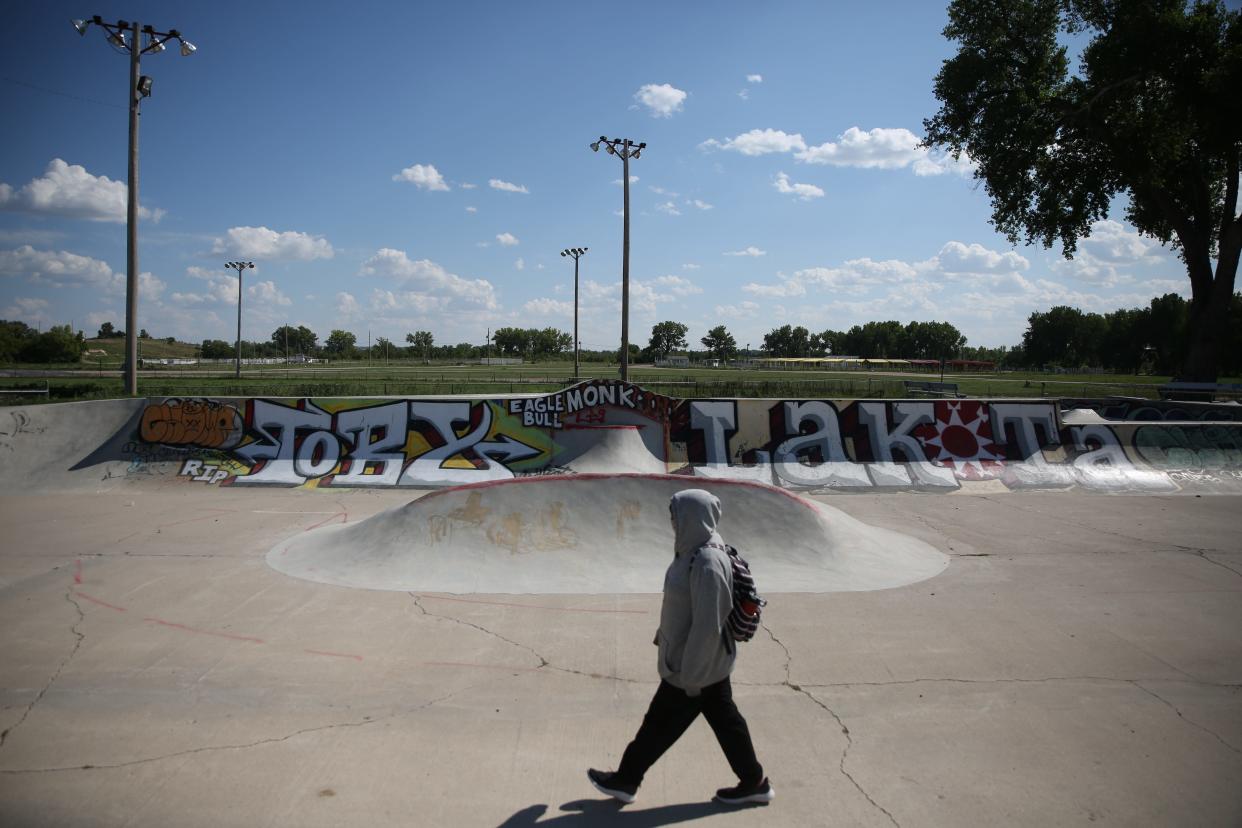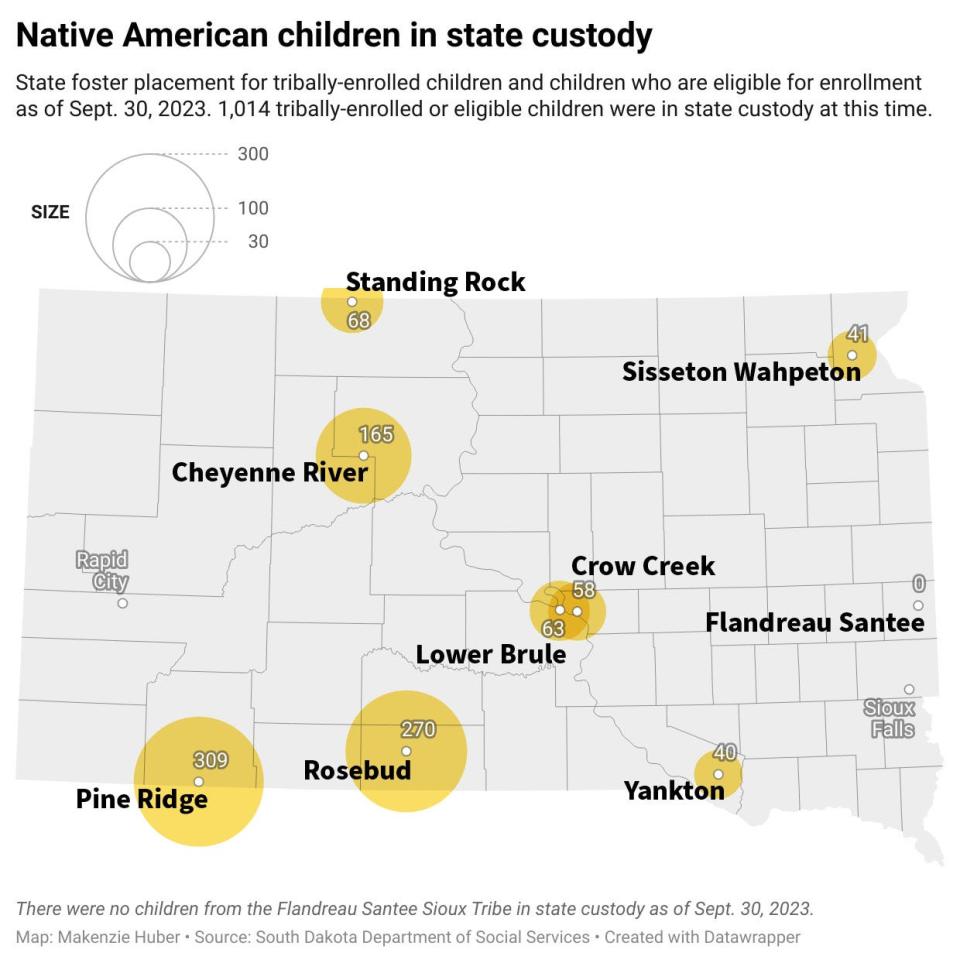A story told in data: Overrepresentation of Indigenous children in the SD foster care system

Native American children are overrepresented in South Dakota's child welfare system — accounting for nearly 74% of foster children in the state at the end of fiscal year 2023, despite making up 13% of the state's child population.
That means Indigenous children have a 22% chance of being removed from their families and placed in the foster system before they turn 18 — seven times higher than a white South Dakota child's risk of entering the system, according to studies examining the risk of foster care placement for children across the nation.
White children accounted for 21% of the child welfare system at the end of fiscal year 2023. They make up 70% of the state's child population.
According to state Department of Social Services Secretary Matt Althoff, most child welfare cases are due to parental substance abuse.
While South Dakota Searchlight and the Argus Leader did not receive reasons for foster care entry data from the state DSS in time for the publication of The Lost Children series, national data says neglect is the leading reason children are placed into foster care in the state (68% of cases), followed by substance abuse (57% of cases).
Those are commonly the leading reasons children are placed into foster care in states surrounding South Dakota as well. Where South Dakota stands apart from its peers is the number of children entering foster care due to parental incarceration. Over 25% of cases cite parental incarceration in the state, while the average percentage for surrounding states is 10%.
And while Indigenous children make up nearly three-quarters of the state's foster children, Native American foster families account for 11% of foster homes in the state.
Gov. Kristi Noem’s administration made it a goal with her Stronger Families Together initiative to recruit 300 newly licensed foster families each year. According to a records request filed with the state Department of Social Services, the number of newly recruited foster families doubled in the initiative's first full year of implementation (246 in fiscal year 2022) but dropped to 183 families the following year. While that's a 12% increase from 2021, it does not meet DSS’ defined goal to recruit 300 new foster families each fiscal year.
As of June 2023, there were 89 Native American foster homes licensed with the state — a 53% increase in Indigenous foster homes since 2012.
Since Gov. Kristi Noem’s Stronger Families initiative began in 2021, state-licensed Native American foster families have increased by just over 2%.
The discrepancy in Native and non-Native foster homes can make it more difficult for a child to live in a home similar to their upbringing (meant to avoid shock or trauma) and can often mean they're shipped hundreds of miles away from their hometowns to a non-Native community. Such distance can make it difficult for children to connect with their cultural heritage, but it can also make it difficult to achieve successful family reunification.
In fact, about 40% of Native American foster children in South Dakota reunify with their family. Other ethnicities, such as white, Black and Hispanic foster children have reunification rates between 60% and 70%.
Outside of reunification, kinship (family care) is the second priority placement for children outside of foster care. Although the family member is not a legal guardian of the child and the child is still not reunified with their parents, the state and federal government consider this an exit from the foster system. Kinship families do not receive financial support like foster families do when they take in a child in South Dakota.
In South Dakota, about a quarter of all children exited the foster system into a kinship placement, guardianship or relative adoption. The third exit category was foster parent adoption.
For South Dakota children who enter the foster care system, about three-fourths are entering the child welfare system for the first time. But 25% of children are re-entering the system. South Dakota's rate of foster care entry per 1,000 children in 2021 was 6.4, which was the second highest rate among surrounding states.
The number of children who are up for adoption in South Dakota and whose parents' rights have been terminated rose by 40% from 2017 to 2021.
This rise correlates with a 16.5% uptick in children in the foster care system during that time.
The 1978 federal Indian Child Welfare Act, inspired in part by South Dakota, was meant to implement safeguards to prevent the overrepresentation of Native American children in the foster care system.
While most states in the Upper Midwest, Great Plains and West have adopted state ICWA laws to codify portions of federal law or enhance it to fit state needs, South Dakota is one of the few states that has not implemented a state ICWA law.
In addition to rejecting two bills that would have codified pieces of ICWA into South Dakota statute, the state Legislature rejected a bill last winter that would have created a new task force to further study the issue of overrepresentation.
In fiscal year 2023, there were 549 open ICWA cases. Most of those children were enrolled or eligible members of the Oglala Sioux Tribe on the Pine Ridge Reservation. There were several Native American children who did not have ICWA cases for various reasons.
Although there were 549 open ICWA cases in South Dakota in fiscal year 2023, over 1,000 tribally enrolled and eligible Native American children were in state custody as of Sept. 30, 2023.

This article originally appeared on Sioux Falls Argus Leader: Overrepresentation of Native children in foster care in data form

